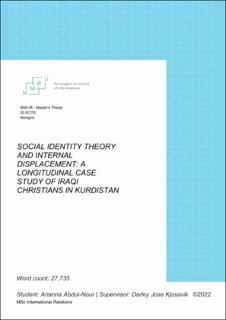| dc.description.abstract | In February 2020, the United Nations (UN) Secretary-General’s High-Level Panel (HLP) on internal displacement set out to establish concrete solutions to the perennial exodus of millions of people across the globe. With the World Health Organization (WHO) declaring COVID-19 a global pandemic two weeks later, proceedings were put on hold so that individuals could limit their movement and stay safe in the security of their homes. However, for millions across the globe, the threats presented by the virus were offset by threats of conflicts or disasters. Remaining at home was not an option for everyone. With the last report of displacement documenting an upshot of 55 million internally displaced people (IDP) in 2020 (IDMC, 2021), the next set of statistics after a global pandemic and Europe’s largest forced displacement crisis in decades currently taking place in Ukraine, will be far more disturbing. Unlike refugees who have crossed a border and are, therefore, protected under the 1951 Refugee Convention, IDPs exist in a legal void. The fact they remain within the geographical parameters of their country, alongside the United Nations High Commissioner for Refugees’ (UNHCR’s) inaction for fear of violating national sovereignty, mean that the plight of this community continues to intensify. Despite the existence of normative UNHCR frameworks, including the recent establishment of the HLP, these projects have so far only paid lip service to participatory rhetoric (Erdem, Özevin and Özselçuk, 2003). No formal protection of, or accountability for, this group has been formulated.
In the context of the unremitting crisis of protracted internal displacement, this empirical longitudinal study draws attention to the critical inadequacies of the international community in meaningfully responding to the problem of chronic displacement. Specifically, this study extends social identity theory (SIT) to include elements based on internal migration and religious persecution in order to examine the case of autochthonous Christian minorities from Iraq who currently live as protracted IDPs under the Kurdish Regional Government (KRG). Drawing on key SIT concepts, such as optimal distinctiveness theory (ODT), and existing IDP literature, this study theoretically analyses first-hand accounts of displacement to frame the effects of liminality in hyphenated spaces on the construction of personal identity. The key contribution of this research is to highlight the urgency for legal definitions of internal displacement and legally binding constitutional provisions, including a distinct case for ethno-religious IDPs. This thesis makes the case for comprehensive monitoring and assessment mechanisms that prudently oversee viable and durable solutions to displacement in order to foster positive identities. The insights generated contribute to understanding a hugely neglected domain of migration at a juncture where the stalemates of debates concerning solutions to the current status quo are acutely unsustainable. | en_US |

